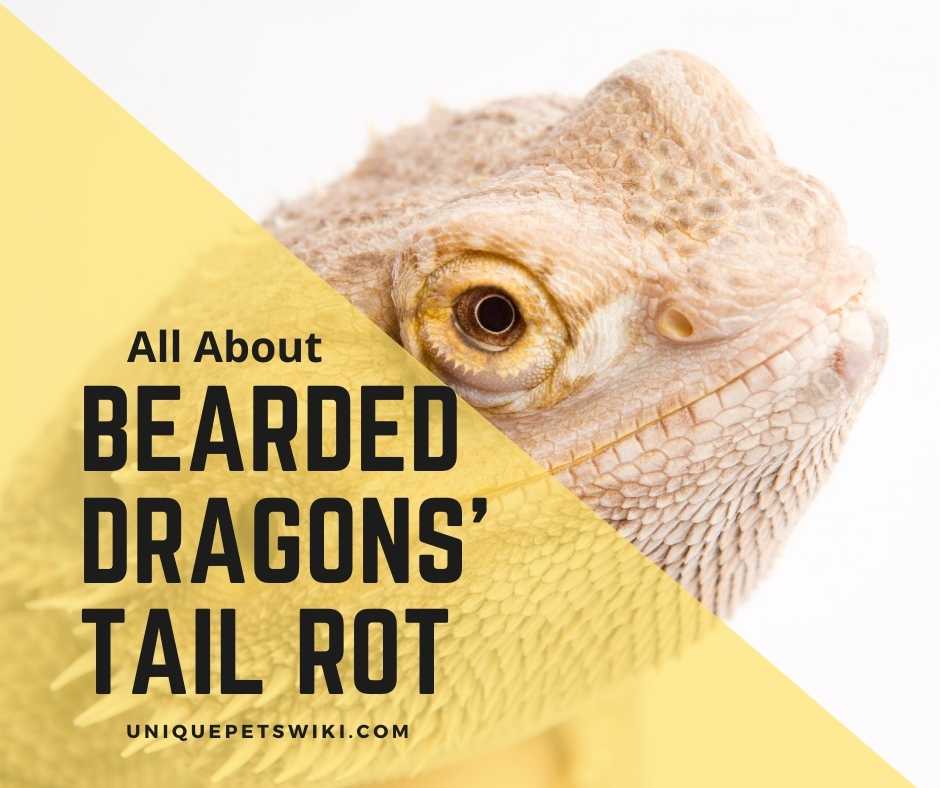Tail rot in bearded dragons is not a joke and can result in enormous damage if it is not timely addressed. Tail rot is not new to the beardies; in fact, many dragons suffer from this disease without their owners noticing.
Imagine yourself waking up and recognizing a dark spot in your toe that keeps on spreading. It is a horrible experience and overwhelming, right?
We’ll learn everything about tail rot in beardies from prevention, identification, treatment, and much more. Don’t miss any bit of the discussion below; you will be glad you read it.
This article has been reviewed by Dr. Dilber. Read more about our knowledge control process here.
Contents
What is Tail Rot in Bearded Dragons?
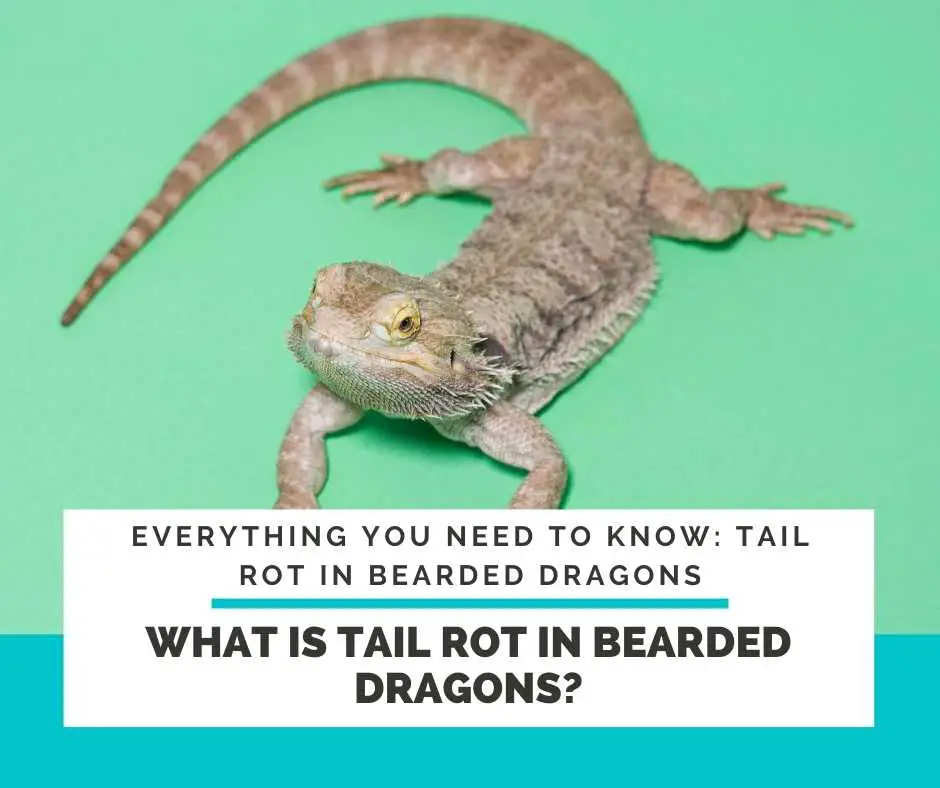
When you hear tail rot, what comes in your mind? Tail rot can be more dangerous than you may think, and sometimes it can even lead to the death of your pet. Losing a pet is painful, and I know this is the last thing you want.
It is paramount for every dragon owner to be educated about tail rot to help them avert this devastating disease from affecting their pet.
With the right knowledge, you will be able to take the proper measures if you suspect your pet to be suffering from tail rot.
Tail rot or necrosis is a widespread disorder in bearded dragons and other reptiles that involve rotting of the tail because of various reasons as we are going to see. In some instances, the toes can also be affected.
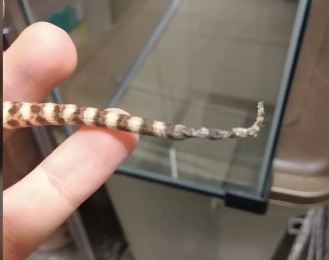
(Source: Dragon Smart YouTube)
If a beardie has tail rot, it means that the blood is not circulating through the tail. The condition tends to spread quickly and can even extend to other parts of the body and damage the internal organs.
How Do Bearded Dragons Get Tail Rot?
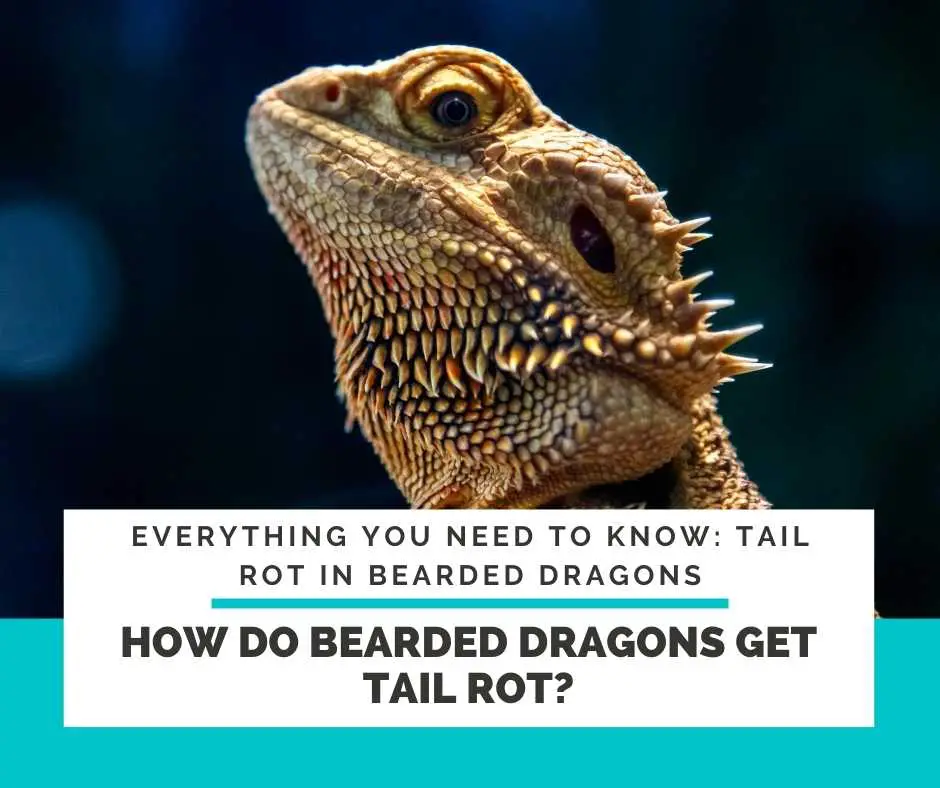
Poor management and nutrition expose your pets or any other domesticated animal to dangerous diseases and increases the cost of production.
New to bearded dragon? Check out the bearded dragon care sheet now! We had listed out all the things you need to know about bearded dragons as pets. Check it now!
Tail rot is common in bearded dragons, as we have seen. Below are the possible causes of this cruel disease.
Incomplete Shedding
High moisture prevents the falling of dead cells from the skin. Besides that, moisture also prevents the shrinkage of cells while shedding.
In low humidity, shedding is not completed in most instances. The dead skin on the tail that does not shed because of humidity problems begins to rot. As the skin rots, it affects the tail that starts rotting as well.
The dead cells on the skin affect surrounding live cells and they start rotting.
Malnourishment
The best way to care for your beardie is by providing a well-balanced and healthy food to make the pet stay healthy. Bearded dragon diet should consist of vegetables, greens, insects, fruits, calcium, and vitamin supplements.
Calcium and vitamins are occasional ingredients and are needed for healthy bone formation. Lack of calcium affects bone structure making the bones become weaker.
The weakening of the bones in the tail exposes the beardie to infections that can develop to tail rot.
Inadequate UVB Rays
Bearded dragons require UVB to be able to digest and absorb the right amounts of calcium from the food and into the body. UVB rays activate vitamin D to D3 that becomes available for the absorption of calcium.
Inadequate UVB rays mean no vitamin D3, and it interferes with calcium absorption, thus weak bones and, eventually, tail rot.
Poor Hygiene
Keeping the beardie and the enclosure clean is a must to help prevent many infections that can affect your beardie.
If you don’t wash your beardie, foreign particles sticking on the tail attract the parasites that may result in infections, and your pet may not escape tail rot.
Tail Bite
Having multiple bearded dragons in a single tank is something you should always avoid.
The beardies are solitary lizards, housing them in one cage is like having two enemies under one roof. They can’t tolerate each other, and they will always get into severe fights.
The Fighting can result in injuries as the beardies bite on each other, and the tail is not exempted. Also, a dragon can bite another dragon’s tail, thinking it to be food. You can also unknowingly buy a dragon with tail rot from the pet store.
In the case of insects like crickets in the tanks, they can bite your beardie’s tail when they are hungry and cause injuries.
The wound caused may be the reason for tail rot. To avoid this problem, always ensure no crickets are remaining in the enclosure after feeding.
A beardie can also bite its tail as a result of itching or pain. Itching is common when the dragon is shedding.
To prevent this problem, make sure there is high humidity in the enclosure to make the shedding process easy and fast. Soaking the tail can also be a good option.
Trauma
Bearded dragons can get tail rot when the tail is subjected to injuries as we have seen, and also due to tail break and constriction. A beardie can, unfortunately, fall off from high places and break its tail and cut the flow of blood through the tail.
You can also accidentally constrict your beardie’s tail on the door when opening or closing, or it can get stuck on the accessories.
Trauma and injuries increase the entry of inflammatory cells into the tail tissues. If the immune system of a bearded dragon is suppressed, it does not respond well to treat the trauma. As a result, the cells and tissues of the tail start rotting.
Symptoms of Tail Rot in Bearded Dragons
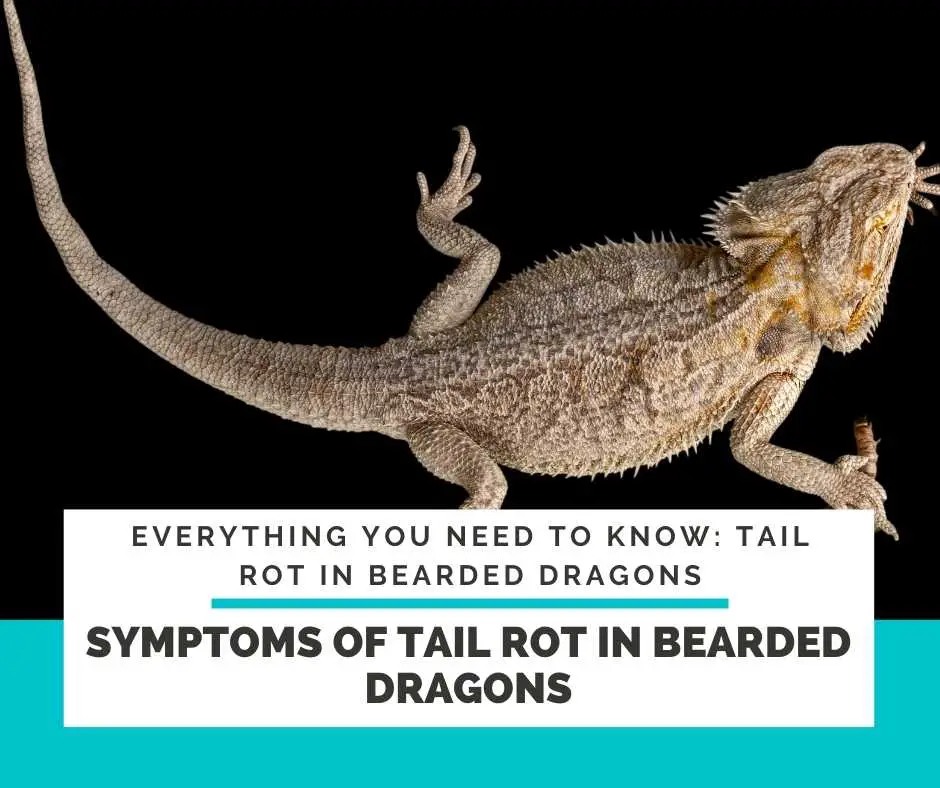
It is always easy to tell if a bearded dragon is suffering from tail rot if you are familiar with the possible signs.
Several signs are associated with tail rot that every person who is owning a bearded dragon needs to know. Check them on the list below.
- The tail appears black in the affected region.
- The tail appears dry, and it is hard to touch.
- A dragon that is having a tail rot may display a black beard.
- The beardie gets irritated, and sometimes it tends to hide in the enclosure, and it is prone to biting.
- The tail appears to break easily.
- Death of the affected part.
- There is no shedding on the tail.
- Tail decay, and it can eventually fall off.
- Anorexia.
- Sometimes the beardie feels pain when you touch the tail.
- The affected part appears inflexible.
- Discoloration of tail
- tail gets shrink
- Dryness
- Deformed tail
- The bearded dragon will not move its tail and keep it in the same position.
Be careful not to confuse a bearded dragon having a black tail as a natural coloration to be suffering from tail rot. A healthy black tail will feel warm, and it is not hard. Stress can also cause your dragon’s tail and beard to turn black.
Tail rot should be handled as a serious matter because it can be dangerous if the beardie does not receive proper and prompt treatment. Rotting may work its way up from the tip of the tail and eventually result in systemic illnesses.
In other instances, if the condition is untreated, the beardie may end up losing its tail, which gets detached and falls off ultimately.
New to bearded dragon? Check out the bearded dragon care sheet now! We had listed out all the things you need to know about bearded dragons as pets. Check it now!
Treatment for Tail Rot in Bearded Dragon
Now that you find your beardie has tail necrosis, the only thing to do is aim for treatment. Once the disease is there, no prevention but only medication.
In some situations, tail rot is only a minor problem, and you will want to look for quickest measures to address it yourself.
However, the best step to take when you suspect your beardie to be suffering from tail necrosis is taking it to a vet. Make sure to look for an experienced veterinarian who has handled exotic reptiles like bearded dragons before.
At first glance, most vets will be able to know whether the beardie has tail necrosis or not. In some situations, the vet will need to diagnose the beardie and perform some blood tests to be confident that it is tail rot.
Blood testing in most cases is the best option because the vet gets to know the real problem and the right antibiotics to use.
Depending on the severity of the condition, your reptile vet may choose to perform surgery or leave the tail not amputated.
You may not take it easy to have your beardie’s tail cut off, especially after knowing that it will never grow back. However, if it is the only way to stop the rotting issue from spreading, then there is nothing you can do.
A surgical tail incision helps to remove the decaying tissues, which stop the problem from progressing. Though, if you detect the problem early and involve the vet right away, it will help to save your pet’s tail before the problem develops further.
Visiting a vet may be more expensive and time-consuming, making it unaffordable to all people. To avoid the extra costs, you will want to look for cheaper alternative methods to get rid of tail necrosis. You can try the following method at home.
Home Remedy
If you are unable to get to the veterinarian, you can try this home remedy and see whether it will be valid for your pet.
Note that this method is only recommended in the early days when tail rot starts to develop.
Choosing to use a home remedy is a matter of trial because you are not confident that the beardie will respond well to the treatment. But it is always good to try.
Many people have found the method to be effective in treating their beardies in terms of tail rotting. Here is how to go about it.
- Buy Betadine and collect some water.
- Get a dish that is deep enough to submerge the affected part of your bearded dragon.
- Put one-part Betadine and three parts water in the dish and mix until you have a solution looking like dark tea.
- Hold the beardie gently and submerge the tail in the solution; make sure that about one inch above the affected area of the tail gets into contact with the liquid.
- Hold the tail in the liquid for about 5-6 minutes to soak up the antibacterial cleansing liquid.
- Remove the tail and dry it with a clean cloth or tissue paper. Be careful and gentle when drying because the rotting tail tends to be delicate and easily broken.
- The next thing after drying is to apply some antibiotic ointment such as Neosporin.
- Repeat the above procedure about 2-3 times in a day for one week, but ideally two weeks. Beware that some antibiotics may be strong for baby bearded dragons. So, make sure you consult from your reptile vet to get the best prescription.
How to Prevent Tail Necrosis in Bearded Dragons
Tail necrosis is a common health issue in the bearded dragon, but it doesn’t mean that you can’t prevent it. You can live peacefully with your beardie without any disease occurrence under extreme proper care.
Prevention is better than cure; don’t wait to run during the last hours when the beardie is already sick. Frequent treatment of wounds, injuries, or trauma. Here are various ways to help prevent tail rot in bearded dragons.
Proper Nutrition
Make sure your dragon is getting a healthy and well-balanced diet at all times to keep it healthy and looking good. A healthy pet has high immunity, and it can fight a lot of diseases.
Increase the number of antioxidants in the diet of the bearded dragon.
Buy a Healthy Beardie
To avoid buying dragons with illnesses, always make sure you make your purchase from a pet store or breeder with a good reputation. Also, involve a reptile vet to check on the dragon’s health condition before bringing it home.
Avoid Keeping Two Beardies in One Tank
Suppose you have several dragons and can afford to keep them in separate habitats, it will be much better. It will help prevent violence and competition for food, heat, space, and more: no fight, no injuries, or tail bites.
Especially avoid keeping two males in a tank.
Clean the Enclosure Regularly
The foremost thing is to ensure you orient your eyes through the enclosure before use to check for the potential safety concerns.
Keep your beardie’s cage as clean as possible, and ensure that ventilations are working effectively. Disinfect the entire house after every cleaning and provide clean beddings. It helps to control parasites and keep the house in good condition.
Visit a Reptile Vet More Often
It is crucial to have your bearded dragon checked on frequently by an experienced reptile vet on dragon’s care. It increases your confidence that you are raising a healthy pet, and there are no health issues.
Provide Sufficient Amount of UVB
An adequate amount of UVB is a must in bearded dragons. UVB is necessary for the absorption of calcium from the diet to the body and is essential for the development of strong bones. Lack of UVB weakens the bones and can lead to tail rot.
Leave the Beardie to Shed its Skin on its Own
Sometimes you may notice that skin parts are remaining after shedding, and you may be tempted to remove it. But never do that, it can make things to be severe. The best thing is to provide the correct humidity level in the enclosure to make the shedding process easy and efficient.
Can Tail Rot Kill Your Beardie?
Tail rot is not something that you can ignore; it can be dangerous, depending on how severe the condition is.
If tail rot is not identified during the early days, the problem keeps on increasing, and it can progress beyond the tail and affect other parts of the body.
The first thing to realize is your dragon’s tail falling off completely. If the body organs are affected, you can quickly lose your pet. Tail rot is among the diseases that can kill a bearded dragon if there are no treatments.
Now that you know how dangerous tail rot can be try every way you can to keep it away from your beardie. If you believe your beardie is suffering from tail rot, contact or visit your reptile vet immediately.
Conclusion
I really hope that you found the article to be insightful, and now you understand tail rot, its symptoms, treatment, and prevention. A bearded dragon having a tail rot is not always due to inadequate keeping.
Tail rot is not something you should fear. As a responsible owner, you should always be dedicated to caring for your beardie and keep tail rot at bay.
